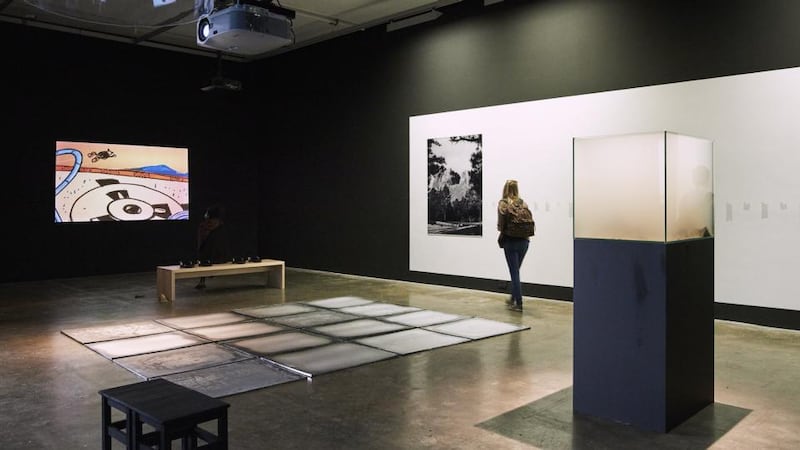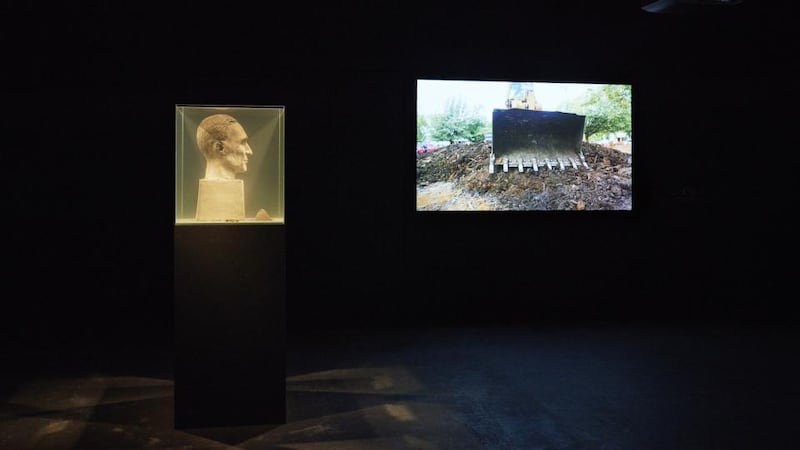RIDDLE OF THE BURIAL GROUNDS
Lara Almarcegui, Rossella Biscotti, Simon Boudvin, Matthew Buckingham, Mariana Castillo Deball, Dorothy Cross, Regina de Miguel, Harun Farocki, Peter Galison & Robb Moss, Stéphane Béna Hanly, Tracy Hanna, Mikhail Karikis & Uriel Orlow, Nicholas Mangan, Tejal Shah
Project Arts Centre, Dublin


****
Cuban artist Lara Almarcegui was actually given permission to obliterate an abandoned house for her seven-minute video Buried House, Dallas. A house is briskly demolished and pulverised with breath-taking ease by a piece of heavy machinery, which then deposits the shattered pieces in a hole in the ground and smooths over the surface, as though the house had never been.
Personal possessions and other evidence of habitation also disappear into the ground, and you might begin to worry about the people who lived in the house. But it’s art, so you sort of know that everything is fine, as indeed it is.
Almarcegui’s video works on several levels. You can read it as a comment on the subprime mortgage disaster in the US, a prelude to the global financial meltdown that also enveloped Ireland. Or on the notion of private property as a concept. Or, more abstractly and generally, on mortality and the futility of utopian dreams and schemes.
Buried House, Dallas is one of several fascinating works included in curator Tessa Giblin's Riddle of the Burial Grounds. The exhibition is Project's big summer offering, and it extends throughout the whole building, occupying the Gallery, the Cube and the Space Upstairs.
Neat packages
There’s plenty to see and think about, but curators do like to tie things together in one conceptual package. Giblin’s themes never quite comes into focus, or perhaps it’s fairer to say never settle down. Rather, she restlessly and often loosely links the works of art to a number of diverse areas of thought and inquiry, from hard science to cultural theory.
If there is a thread, it’s hard to follow. In greatly distilled form, it might go something like this: Giblin starts with our curiosity about the traces of lost civilisations and wonders what our own society will bequeath to the distant future. We will, she suggests, certainly leave numerous traces of plundered natural resources, as well as growing quantities of nuclear waste (the show’s title refers to the question of how to signal that waste for future generations) and other toxic residue.
Giblin is taken by Paul Crutzen's description of our current geological era as the Anthropocene – that is, the first in which human activity is the decisive factor having an impact on and shaping the future of the planet on a geological scale.
Several pieces treat the idea of a poisonous legacy. Throughout the show you encounter several cloudy tanks of water in which masses of clay are disintegrating. They are instalments from a series by Stéphane Béna Hanly, Length of a Legacy. Each was at one point a portrait bust in the style of a classical commemorative statue.
The three subjects are Thomas Midgley, Robert Oppenheimer and Alexander Parkes. Oppenheimer is famous as the physicist who headed the Manhattan Project, which ushered in the atomic age. The less famous Midgley was a refrigeration scientist who unwittingly created CFCs. Refrigeration good, CFCs bad. Their devastating effect on the ozone layer was only discovered years after Midgley’s death. Without intending any harm, Midgley managed, as one writer put it, to have “more impact on the atmosphere than any other single organism in Earth’s history”. Parkes, the inventor of plastic, also left a distinctly mixed legacy.
Submerged in water, Hanly’s portrait busts succumb to accelerated erosion.
Rushmore in ruins
Erosion is starkly visualised in another work, Matthew Buckingham's The Six Grandfathers, Paha Sapa, in the Year 502,002 CE. He anticipates what Mount Rushmore will look like half a million years into the future. Predictably, the famous presidential likenesses will be worn away to nothing.
Buckingham charts a timeline that extends back to the mountain’s geological beginnings and its role in the lives of those who have lived in its shadow, a long and complex history in which the current presidential phase is but one ephemeral episode.
The late influential Harun Farocki was a pioneer and master of using the short film essay form in new and diverse ways, and two works in the show provide a good illustration of his range and potential.
One of the shorts, made in 1969, is a fictionalised account of the production of napalm during the Vietnamese war. Inextinguishable Fire is a powerful study of how "civilised" people can, without any directly malign intention, participate in unimaginable horror – and how the horror remains curiously and conveniently remote and unimaginable, no matter what.
In quite a different vein, the other, Transmission (2007), shows visitors engaging with a succession of sacred sites and monuments. The transmission in question happens as each individual touches the object charged with symbolic meaning.
The most beautiful pieces in the show are probably Dorothy Cross's film Stalactite and Nicholas Mangan's A World Undone. The latter is a spaced-out film, shot at 2,500 frames per second, recording the disintegration of a tiny piece of zircon. Dated to 4.4 billion years, zircon is one of Earth's oldest minerals, and Mangan uses it to leapfrog back in time to the formation of the universe. At least that's what the film, of masses of particles spinning endlessly through space, seems to suggest.
It is well partnered with Stalactite, projected on the opposite wall. Cross juxtaposes the Great Stalactite in Pol an Ionain near Doolin, Co Clare, formed incrementally over hundreds of thousands of years, with a boy soprano whose voice is on the verge of breaking: the rhythm of human life unfolds against the slow pulse of geological time.
- Until August 1st, projectartscentre.ie












